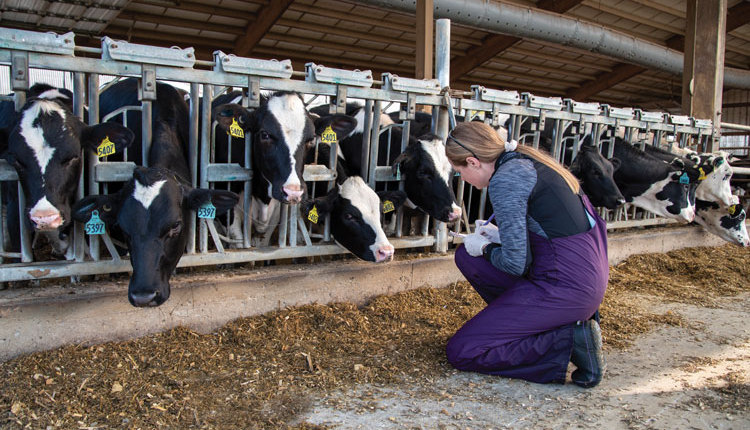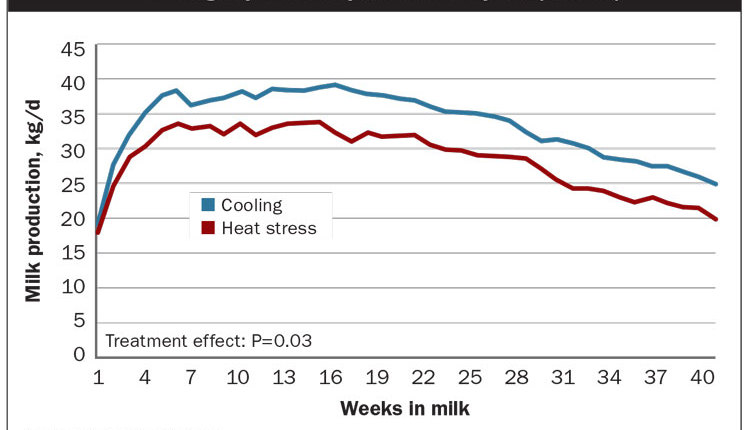The author is at Sterner Veterinary Clinic, Ionia, Mich. This article is part of a series being prepared in cooperation with the American Association of Bovine Practitioners.

What factors impact drug choices that veterinarians make? Perhaps the single biggest influence is their professional training and experience. In other words, we use a variety of criteria.
By training, most veterinary students learn a lot about the pharmacology of drugs. That is the theoretical part of a veterinarian's training. Then, we proceed to the working world where our real education begins! It is usually in field settings that we learn about how many considerations there are when selecting a drug for use in treating a case.
Just as a drug company seeks to gain FDA approval for a drug, veterinarians must consider three primary factors. First, will the drug work for the condition(s) we are attempting to treat? Second, is it safe for the animal that we intend to use it on? And, finally, are the food products derived from this treated animal going to be safe for human consumption after appropriate withholding?
We have many sources of laws, regulations, and guidelines. Chief among the guidelines we use are general recommendations set out by our professional associations. These guidelines give recommendations as to proper drug use and withdrawal procedures.
In addition, there is an FDA list of specifically prohibited drugs. These may not be used under any circumstances in food-producing animals. An example is chloramphenicol.
Often, it seems as if there are far more don'ts than do's! At the same time, there is a federal law called the Animal Medicinal Drug Use Clarification Act (AMDUCA) that does allow a licensed veterinarian to use drugs (other than those on the FDA prohibited list) in a manner that may not specifically be indicated on the drug label. It is allowable so long as it is within the context of a veterinarian-client-patient relationship (VCPR). AMDUCA does not provide for any protection for either the producer or the veterinarian if such treatments result in violative residues.
Many dairy industry organizations have worked with veterinary organizations and state agencies to produce drug use guidelines as well. An example is the National Beef Quality Assurance guidelines. They are intended for both producers and veterinarians and designed to ensure that those who are providing treatments to animals on farms are making the correct drug choices and observing proper withholding periods. While these guidelines are intended to be just that, they are not a substitute for a valid veterinarian-client-patient relationship.
When a veterinarian is presented with a patient that needs medication for pain relief, they are faced with severely limited options. Thus, the veterinarian is faced with the difficult decision to either provide pain relief for their patient or elect humane euthanasia rather than risking violative drug residues.
In recent years, dairy cattle treated with flunixin meglumine have been a growing source of concern by the USDA because of violative residues found in tissues of marketed cows. Many of these violations have been caused by extra-label use of the drug because it was administered by a different route than intravenously.
The organic question
Given today's niche markets for organically produced food products, there are confusing choices when it comes to deciding when to treat an animal and with which drugs to treat. There are very few FDA-approved organic or homeopathic remedies. The National Organic Standards Board "approves" a list of products for use in organic production systems. These may include some FDA-approved products with a New Animal Drug Application (NADA). NADA is FDA's official process that provides assurance that a drug has gone through a full FDA review and approval. The National Organic Standards Board does not have legal authority to grant a product NADA status. It only provides a list of products that may be used to treat animals in a manner that food derived from treated animals can be certified organic.
An example of a drug that has a NADA from FDA, and is approved for use in cattle with appropriate withholding periods after treatment, would be Procaine Penicillin G. However, Procaine Penicillin G is not approved for use in cattle that are part of an organic production system. An example of a drug that has a NADA from FDA and is on the "approved" list for use in organic livestock production is Ivermectin.
An example of an organic substance on the National Organic Standards Board "approved" list but does not have an NADA would be Fossil Shell Flour which has a claim for control of internal parasites. Utilization of these "approved" products is no guarantee that an organic or homeopathic treatment does not have the potential to produce harmful residues in foods. In the past, FDA has prosecuted individuals selling "organic" compounds and medicines which falsely purported to have no withdrawals, such as products with colloidal silver or aloe vera.
Seek sound advice
The thought process you and your vet must employ when deciding on a treatment for a particular problem can be both complex and confusing. As a producer, you should enlist the service of a competent and trusted advisor when it comes to establishing treatments and drug choices for problems cows may develop on your farm. Anything less can contribute to a loss of consumer confidence in the wholesomeness and safety of the nation's food supply.
To get more information
For further drug use guideline reading via the internet, please use the following references:
1. Cattle drug use and treatment guidelines -www.avma.org/issues/policy/jtua_cattle.asp
2. Prohibited drugs -www.farad.org/eldu/prohibit.html
3. Approved list of organic substances used in organic livestock production -www.mosaorganic.org -
search archives Jun-Jul 2009 issue page 9
4. A list of synthetic substances allowed for use in organic livestock production -www.bit.ly/aNmxge
Click here to return to the Animal Care E-Sources
101010_652

Our tools to optimize our animals' production, health, and well-being include medications which are used to treat animals as needed and enhance production or reproduction. This article is part of a series that examines the best use of medications to enhance their effectiveness and the safety of the food we produce.
What factors impact drug choices that veterinarians make? Perhaps the single biggest influence is their professional training and experience. In other words, we use a variety of criteria.
By training, most veterinary students learn a lot about the pharmacology of drugs. That is the theoretical part of a veterinarian's training. Then, we proceed to the working world where our real education begins! It is usually in field settings that we learn about how many considerations there are when selecting a drug for use in treating a case.
Just as a drug company seeks to gain FDA approval for a drug, veterinarians must consider three primary factors. First, will the drug work for the condition(s) we are attempting to treat? Second, is it safe for the animal that we intend to use it on? And, finally, are the food products derived from this treated animal going to be safe for human consumption after appropriate withholding?
We have many sources of laws, regulations, and guidelines. Chief among the guidelines we use are general recommendations set out by our professional associations. These guidelines give recommendations as to proper drug use and withdrawal procedures.
In addition, there is an FDA list of specifically prohibited drugs. These may not be used under any circumstances in food-producing animals. An example is chloramphenicol.
Often, it seems as if there are far more don'ts than do's! At the same time, there is a federal law called the Animal Medicinal Drug Use Clarification Act (AMDUCA) that does allow a licensed veterinarian to use drugs (other than those on the FDA prohibited list) in a manner that may not specifically be indicated on the drug label. It is allowable so long as it is within the context of a veterinarian-client-patient relationship (VCPR). AMDUCA does not provide for any protection for either the producer or the veterinarian if such treatments result in violative residues.
Many dairy industry organizations have worked with veterinary organizations and state agencies to produce drug use guidelines as well. An example is the National Beef Quality Assurance guidelines. They are intended for both producers and veterinarians and designed to ensure that those who are providing treatments to animals on farms are making the correct drug choices and observing proper withholding periods. While these guidelines are intended to be just that, they are not a substitute for a valid veterinarian-client-patient relationship.
When a veterinarian is presented with a patient that needs medication for pain relief, they are faced with severely limited options. Thus, the veterinarian is faced with the difficult decision to either provide pain relief for their patient or elect humane euthanasia rather than risking violative drug residues.
In recent years, dairy cattle treated with flunixin meglumine have been a growing source of concern by the USDA because of violative residues found in tissues of marketed cows. Many of these violations have been caused by extra-label use of the drug because it was administered by a different route than intravenously.
The organic question
Given today's niche markets for organically produced food products, there are confusing choices when it comes to deciding when to treat an animal and with which drugs to treat. There are very few FDA-approved organic or homeopathic remedies. The National Organic Standards Board "approves" a list of products for use in organic production systems. These may include some FDA-approved products with a New Animal Drug Application (NADA). NADA is FDA's official process that provides assurance that a drug has gone through a full FDA review and approval. The National Organic Standards Board does not have legal authority to grant a product NADA status. It only provides a list of products that may be used to treat animals in a manner that food derived from treated animals can be certified organic.
An example of a drug that has a NADA from FDA, and is approved for use in cattle with appropriate withholding periods after treatment, would be Procaine Penicillin G. However, Procaine Penicillin G is not approved for use in cattle that are part of an organic production system. An example of a drug that has a NADA from FDA and is on the "approved" list for use in organic livestock production is Ivermectin.
An example of an organic substance on the National Organic Standards Board "approved" list but does not have an NADA would be Fossil Shell Flour which has a claim for control of internal parasites. Utilization of these "approved" products is no guarantee that an organic or homeopathic treatment does not have the potential to produce harmful residues in foods. In the past, FDA has prosecuted individuals selling "organic" compounds and medicines which falsely purported to have no withdrawals, such as products with colloidal silver or aloe vera.
Seek sound advice
The thought process you and your vet must employ when deciding on a treatment for a particular problem can be both complex and confusing. As a producer, you should enlist the service of a competent and trusted advisor when it comes to establishing treatments and drug choices for problems cows may develop on your farm. Anything less can contribute to a loss of consumer confidence in the wholesomeness and safety of the nation's food supply.
To get more information
For further drug use guideline reading via the internet, please use the following references:
1. Cattle drug use and treatment guidelines -www.avma.org/issues/policy/jtua_cattle.asp
2. Prohibited drugs -www.farad.org/eldu/prohibit.html
3. Approved list of organic substances used in organic livestock production -www.mosaorganic.org -
search archives Jun-Jul 2009 issue page 9
4. A list of synthetic substances allowed for use in organic livestock production -www.bit.ly/aNmxge
101010_652








